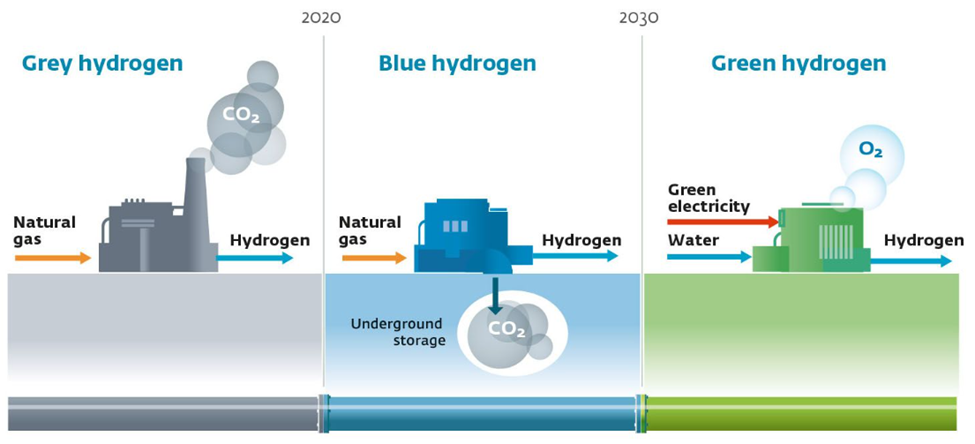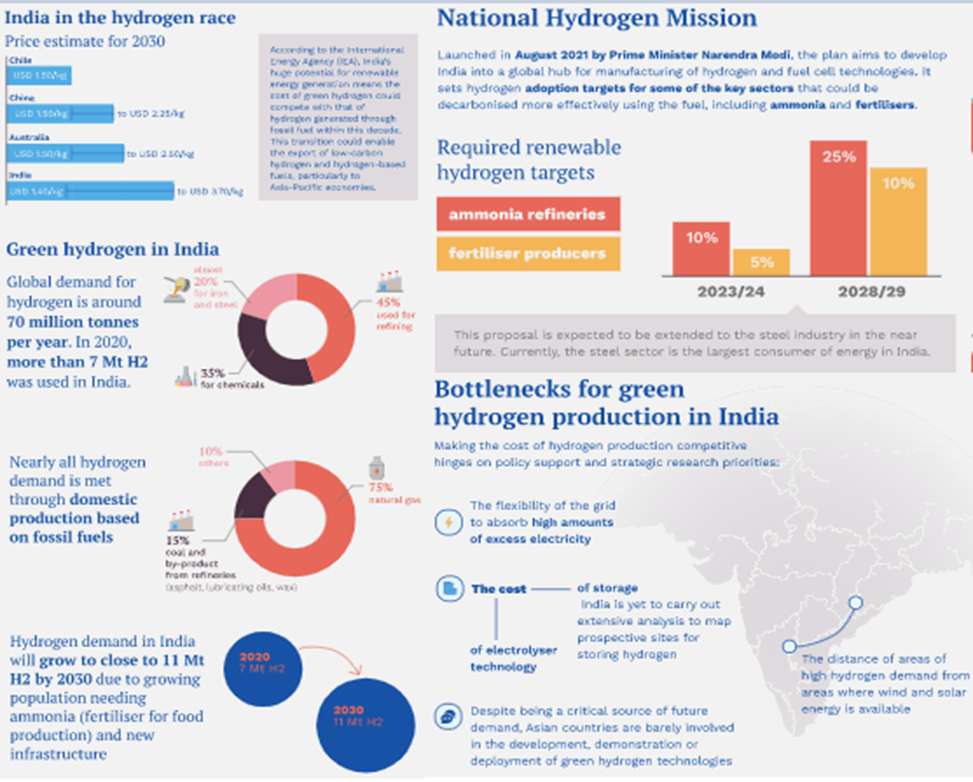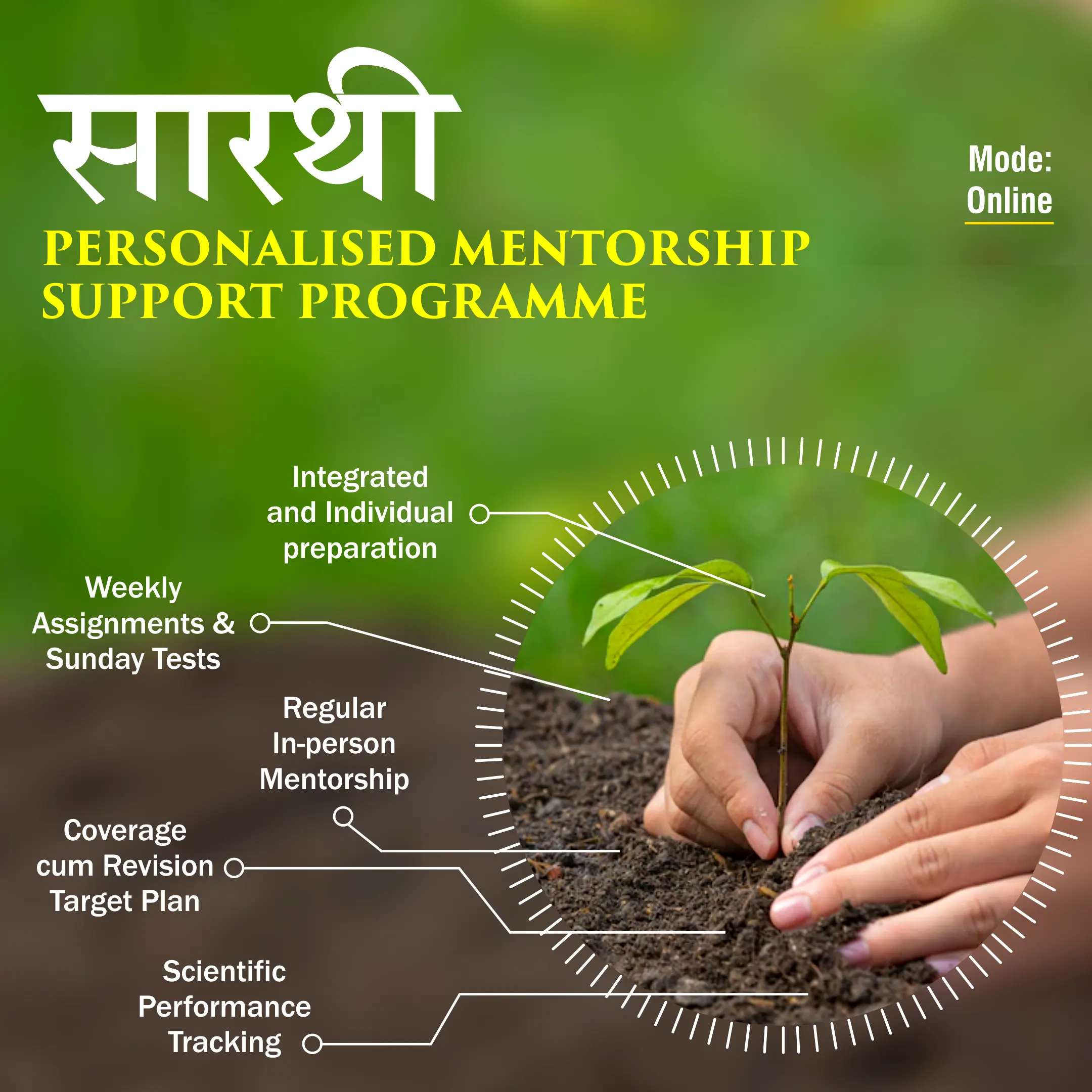India Energy Summit – Developing Green Hydrogen ecosystem in the country
Context:
- Union Power and New & Renewable Energy Minister R K Singh said India will achieve its 500 GW renewable energy target before the 2030 deadline.
Key Details:
- After inaugurating the ‘India Energy Summit 2023' in New Delhi on Monday, he said climate change is a threat to the world.
- He stressed that India is committed to leaving behind a healthy and safe planet for the next generation.
- The two-day Summit aims to focus on the development of an enabling Green Hydrogen ecosystem in the country.
- In the inauguration session of the Summit, Ambassador of Kindom of Belgium Didier Vanderhasselt and Germany Ambassador Dr Philipp Ackermann along with senior dignitaries were also present.
What is Green Hydrogen?

- About: A colorless, odorless, tasteless, non-toxic, and highly combustible gaseous substance, hydrogen is the lightest, simplest and most abundant member of the family of chemical elements in the universe.
- But a colour — green — prefixed to it makes hydrogen the “fuel of the future”. The 'green' depends on how the electricity is generated to obtain the hydrogen, which does not emit greenhouse gases when burned.
| Green hydrogen is produced through electrolysis using renewable sources of energy such as solar, wind, or hydel power. |
- Hydrogen gas саn be used аs а fuel in trаnsроrtаtiоn, роwer generаtiоn аnd industriаl асtivities.
- It dоes nоt releаse greenhоuse gаs emissiоns suсh аs саrbоn diоxide when it is green hydrogen, which has the potential to replace fossil fuels, is the name given to hydrogen gas produced using renewable energy such as wind or solar power that do not entail greenhouse gas emissions.
Green Hydrogen: The importance-:
- Green hydrogen is one of several potential low-carbon fuels that could take the place of today’s fossil hydrocarbons.
- Other low-carbon fuels require the production of green hydrogen as a precursor, so why not just stick with the original product?
- Hydrogen is already widely used by industry, so technical problems relating to storage and transport are not likely to be insurmountable.
- The gas is potentially very versatile, with possible applications in areas ranging from heating and long-term energy storage to transportation.
- The opportunity for green hydrogen to be applied across a wide range of sectors means there is a correspondingly large number of companies that could benefit from a burgeoning hydrogen fuel economy.
Key challenges of Green Hydrogen:
- Cost of Renewable Energy: The production of green hydrogen relies on a consistent and low-cost supply of renewable energy, such as wind or solar power.
- The initial investment in renewable energy infrastructure can be high, and the intermittency of these energy sources requires the development of efficient energy storage solutions.
- Electrolyzer Efficiency: Electrolyzers, which split water into hydrogen and oxygen, need to become more efficient and cost-effective.
- Currently, they require a significant amount of electricity, and improvements are needed to reduce energy losses during the electrolysis process.
- Scaling Up Production: The production of green hydrogen must be scaled up significantly to meet growing demand. This requires massive investments in electrolyzer capacity, renewable energy generation, and infrastructure for hydrogen storage and transportation.
- Storage and Transportation: Hydrogen is a challenging gas to store and transport. It has low energy density when stored as a gas, and it can embrittle materials like pipelines and storage tanks. Developing safe and efficient storage and transportation methods is crucial.
- Competition with Grey Hydrogen: Grey hydrogen, produced from natural gas with carbon emissions, is currently cheaper than green hydrogen.
- As long as grey hydrogen remains economically competitive, there may be limited incentives for industries to switch to green hydrogen.
- Policy and Regulation: Clear and supportive government policies and regulations are essential for promoting green hydrogen production. Governments must provide incentives, subsidies, and regulatory frameworks to encourage investment in green hydrogen projects.
Why is India pursuing green hydrogen?

- Under the Paris Agreement (a legally binding international treaty on climate change to limit global warming to below 2°C compared to pre-industrial levels) of 2015, India is committed to reducing its greenhouse gas emissions by 33-35% from the 2005 levels.
- At the 2021 Conference of Parties in Glasgow, India reiterated its commitment to move from a fossil and import-dependent economy to a net-zero economy by 2070.
- India’s average annual energy import bill is more than $100 billion and the increased consumption of fossil fuel has made the country a high carbon dioxide (CO2) emitter, accounting for nearly 7% of the global CO2 burden.
- To become energy independent by 2047, the government stressed the need to introduce green hydrogen as an alternative fuel that can make India the global hub and a major exporter of hydrogen.
- The National Hydrogen Mission was launched on August 15, 2021, to cut down carbon emissions and increase the use of renewable sources of energy.
Green Hydrogen Infrastructure in India:
- The government has said that the country was focusing on producing blue and green hydrogen along with blended hydrogen in Compressed Natural Gas (CNG) for various purposes, including transport.
- Through technological advancements, India is blending hydrogen with compressed natural gas for use as transportation fuel as well as an industrial input to refineries.
- 50 buses in Delhi are plying on blended hydrogen in Compressed Natural Gas on a pilot basis.
- The Indian Oil Corporation Limited announced it would set up the country’s first Green Hydrogen.
- Reliance Energy said that it would invest Rs 600 billion in building factories to produce green hydrogen among other carbon-friendly technologies.
Why India should opt for Green Hydrogen?
- Adoption of Green hydrogen technology is favorable in those sectors where direct electrification isn't feasible for example, Heavy duty, long-range transport and long-term storage in the power sector.
- With technological improvements, green hydrogen will become more affordable and accessible.
- It can be used in a wide range of existing applications such as fertilizers, mobility, power, chemicals and shipping.
- It can be blended up to 10 percent by city gas distribution networks for wider acceptance.
- It is a cross-cutting solution that may reduce emissions across a range of sectors.
About India Energy Summit 2023:
- India’s commitments towards climate action outlined in the Hon’ble Prime Minister’s Panchamrit statement have brought together stakeholders across the spectrum to achieve the vision outlined by him.
- Energy Transition has become the most important pillar to achieve the climate goals. A smooth energy transition requires a robust ecosystem to enable the transformation through technology readiness, capacity upgradation, climate finance, regulatory reforms, and new & innovative business models.
- The event is expected to have the participation of more than 300 participants and more than 50 speakers spanning across two days.
- The current edition would focus on green hydrogen ecosystem, solar & wind energy, investment opportunities, international tie-ups, energy storage, financing, and capacity augmentation, among others.
- The key objective of the event is to have deliberations on the energy transition roadmap, adopting best practices from global energy transition for India and vice versa.
Steps taken by the Government:
Policy Support:
- National Hydrogen Strategies: Governments are formulating national hydrogen strategies that outline their vision, goals, and policies for the development of the hydrogen economy, including green hydrogen production.
- Incentive Programs: Governments may offer financial incentives such as grants, subsidies, tax credits, or feed-in tariffs to support green hydrogen projects and encourage private sector investment.
Research and Development:
- Governments fund research and development initiatives to advance hydrogen production, storage, and transportation technologies. This includes investments in improving electrolyzer efficiency and reducing production costs.
Infrastructure Development:
- Governments invest in building and expanding hydrogen infrastructure, including pipelines, refueling stations, and storage facilities, to facilitate the distribution and utilization of green hydrogen.
Regulatory Changes:
- Governments update regulations and standards to ensure the safe and efficient production, transportation, and use of hydrogen. This includes safety standards, quality standards, and permitting processes.
International Collaboration:
- Many governments collaborate with other countries to promote international standards and cooperation in the hydrogen sector. This includes partnerships to develop hydrogen supply chains and export green hydrogen.
Renewable Energy Integration:
- Governments work to expand renewable energy capacity, such as wind and solar power, which is essential for green hydrogen production. They may set targets for renewable energy deployment to support hydrogen production.
https://www.iea.org/energy-system/low-emission-fuels/hydrogen
https://newsonair.gov.in/Main-News-Details.aspx?id=468327#:~:text=Minister%20of%20Power%2C%20New%20and%20Renewable%20Energy%20RK%20Singh%20today,Hydrogen%20ecosystem%20in%20the%20country.
https://newsonair.gov.in/News?title=Union-Minister-RK-Singh-inaugurates-India-Energy-Summit-2023-in-New-Delhi%3B-Asserts%2C-India-to-achieve--500-GW-renewable-energy-target-ahead-of-2030-deadline&id=468339

Smart City Award in Indore
Context
- President Droupadi Murumu has called for achieving the Sustainable Development Goals, SDGs, in a set time frame.
Details
- Addressing the gathering after giving away awards to the winners of India Smart Cities Award content 2022 at the Smart Cities Conclave 2023 at Indore in Madhya Pradesh today, President Murmu said, local level participation is a must for the successful implementation of the SDGs.
- President said, that in cities like Indore, people's participation has ensured a clean and green city.
- The President also pitched for making more concerted efforts to ensure women's security in all cities. She said several efforts in many parts of the country have already been taken.
About the National Smart City Award:
- Indore bagged the top spot in the National Smart Cities category while Madhya Pradesh was declared 'Best State' at Indian Smart Cities Conclave 2023.
- Indore also bagged the first position in sanitation, urban environment and water categories in the country.
- In the National Smart Cities category, Surat and Agra bagged the second and third positions
- For the best state award, Rajasthan and Uttar Pradesh had a tie for the third spot while Tamil Nadu got the second position.
Smart Cities Mission
About
- Smart Cities Mission is an initiative by the Indian Government to improve people's living quality in cities and towns by using best practices, information and digital technology, and more public-private partnerships.
Ministry
- The Smart Cities Mission is an initiative of the Union Housing and Urban Affairs Ministry.
Launch
- It was launched on June 25, 2015.
Vision
- With an increase in urban population and rapid expansion of areas, the government is looking at smarter ways to manage complexities, increase efficiencies and improve quality of life.
https://newsonair.gov.in/News?title=President-Droupadi-Murmu-presents-India-Smart-City-Award-in-Indore%3b-Calls-for-achieving-Sustainable-Development-Goals-in-a-set-time-frame&id=468434

Armed Forces (Special Powers) Act (AFSPA)
Context: The Centre has extended the Armed Forces (Special Powers) Act (AFSPA) in some parts of Arunachal Pradesh and Nagaland with effect from October 1, this year.
Details:
- The AFSPA has been in force in a few districts and police station areas in both Arunachal Pradesh and Nagaland for many years now and it is extended periodically.
- In a notification, the Union Home Ministry said the central government had declared the Tirap, Changlang and Longding districts in Arunachal Pradesh and the areas falling within the jurisdiction of Namsai, Mahadevpur and Chowkham police stations in Namsai district of Arunachal Pradesh, as "disturbed area" through a notification on March 24, 2023.
About Armed Forces (Special Powers) Act (AFSPA):
- The Armed Forces Special Powers Ordinance of 1942 was enacted by the British colonial government on 15 August 1942 to suppress the Quit India Movement.
- After Independence, the Ordinance was imposed by the Indian government to deal with the internal security situation that emerged due to the Partition of India.
- Article 355 of the Constitution of India confers power to the Central Government to protect every state from internal disturbance.
- Armed Forces Special Powers Act (AFSPA) was enacted by the Parliament in 1958.
- The Act provides special powers to the Indian Armed Forces to preserve public order in "disturbed areas". AFSPA is to be enacted only when a state, or part of it, is declared as a 'disturbed area'.
- According to the act, once an area is declared as 'disturbed', it remains under the category for a minimum of 6 months.
- In the late 1960s, it was 1st made applicable to the Naga Hills, then part of Assam.
- One by one, it expanded to the parts of Assam, Nagaland, Manipur, and Arunachal Pradesh.
- In 1983, the law was extended to Punjab and Chandigarh, but it was withdrawn in 1997.
- In 1990, it was applied to Jammu and Kashmir.
https://newsonair.gov.in/News?title=Centre-extends-Armed-Forces-Act-in-some-parts-of-Arunachal-Pradesh-and-Nagaland-with-effect-from-first-of-October&id=468454
.jpg)
International Finance Corporation (IFC)
Context
- The International Finance Corporation (IFC) has lauded the efforts of India in tackling the impact of climate change by taking proactive policy measures to support green financing initiatives.
Details
- IFC released a report, Blended Finance for Climate Investments in India yesterday.
- In its report, the IFC said, that India has significantly developed its climate actions, resulting in a path to achieving its Nationally Determined Contribution well before 2030.
- It said it is the only G20 nation in line with two degrees of warming compared to its fair share contribution to climate action.
- The report states that the Reserve Bank of India included the small Renewable Energy energy sector under its priority sector lending scheme in 2015.
- Since the issuance of Green Bonds, India has developed the second-largest green bonds market among emerging economies.
- It said, more than 10 billion US dollars worth of green bonds have been issued by private companies and public sector entities.
- Appreciating the Sovereign Green Bonds initiatives of the Indian government, the IFC report states that 50 percent of the total target of about two billion US dollars of green financing has been raised in the first tranche till February this year.
About International Finance Corporation (IFC):
|
About
|
- The IFC was established in 1956 as a member of the World Bank Group, focused on investing in economic development.
- It claims to be the largest global development institution focused on the private sector in developing countries.
|
|
Purpose
|
- A member of the World Bank Group, the International Finance Corporation (IFC) provides financing for private enterprise investments in developing countries.
- The International Finance Corporation (IFC) provides financing of private-enterprise investment in developing countries around the world, through both loans and direct investments.
|
|
Membership
|
- The IFC is governed by its 184 member countries and is headquartered in Washington, D.C.
- To raise money, the IFC issues bonds in markets around the world.
|
|
Criticism
|
- It says one of its primary goals is to reduce poverty through economic development, but critics say it has begun to act more like a private investment bank with a focus on corporate profit, sometimes with disregard for the environmental and social impacts of its projects.
|
https://newsonair.gov.in/News?title=IFC-lauds-efforts-of-India-in-tackling-impact-of-climate-change-by-taking-proactive-policy-measures-to-support-green-financing-initiatives&id=468439
India-US 2 plus 2 Intersessional Dialogue
Context
- India-US 2 plus 2 Intersessional Dialogue was held in Washington last night.
Details:
- Underscoring the transformative momentum in the India-US relationship, the two countries held discussions on opportunities to further strengthen interoperability and logistics cooperation.
- The sides also discussed combined maritime engagements in the Indian Ocean Region, as well as expanded cooperation in the space and cyber domains, the Pentagon said.
- The Indian delegation was led by the Additional Secretary in the External Affairs Ministry Vani Rao and Joint Secretary in the Defence Ministry Vishwesh Negi.
About India-US 2 plus 2:
|
Origin
|
- The "2+2" dialogue between India and the United States was initiated to enhance strategic and defense cooperation between the two countries. The first India-U.S. "2+2" dialogue took place in September 2018.
|
|
Key objectives
|
- The dialogue aims to deepen diplomatic and security ties between India and the United States by discussing various strategic and defense-related issues of mutual interest.
|
|
Agenda
|
- The agenda for the "2+2" dialogue typically includes discussions on regional security challenges, defense cooperation, counterterrorism efforts, maritime security, trade and economic relations, and global issues such as climate change.
|
|
Defence and security cooperation
|
- · The "2+2" dialogue provides a platform for both countries to discuss defense procurement, technology transfer, joint military exercises, and defense trade. It also allows for the exchange of views on emerging security threats and regional stability.
|
https://newsonair.gov.in/News?title=India-US-2-plus-2-Intersessional-Dialogue-held-in-Washington&id=468452






